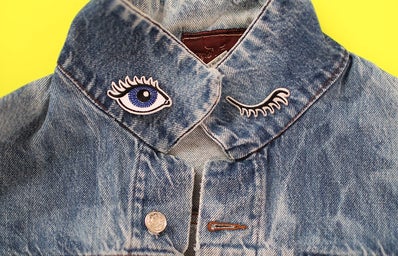Look up “evil eye jewelry” on Etsy, and you’ll get over 118,000 results, ranging from simple rings to 14k gold necklaces. It’s not an exaggeration to say that the Evil Eye, most frequently seen as an almond shaped eye or a concentric dark and light blue circles, has taken over jewelry trends in mainstream fashion. Celebrities like Gigi Hadid and Zayn Malik share matching evil eye bracelets, and even the Duchess of Sussex, Meghan Markle, was seen with her topaz evil eye necklace in a recent Instagram video.
Evil eye jewelry isn’t just exclusive to A-list celebrities; it’s become extremely popular with Gen Zs as well. I’ve seen several of my friends wearing statement rings with the classic blue eye bead. If this sounds familiar, it’s because the emoji of the dark blue circle with a light blue eye in the middle is the evil eye amulet!
Another great example of trendy jewelry for young adults is this gold wire evil eye ring, which has already been sold thousands of times on Etsy. Bedazzled necklaces and dainty chain link bracelets with multi-colored evil eye charms have also become very popular. The symbol is everywhere — but what does the Evil Eye actually mean?
First, it’s important to draw a distinction between the Evil Eye, which is a curse transmitted through a malicious or envious glare, and the evil eye amulet, which protects against the effects of the curse.
The legend of the evil eye curse appeared as far back as 5,000 years ago, long before its debut in the modern fashion industry. In the words of Heliodorus of Emesa in the ancient Greek romance Aethiopica: “When any one looks at what is excellent with an envious eye, he fills the surrounding atmosphere with a pernicious quality, and transmits his own envenomed exhalations into whatever is nearest to him.” Thus, the evil eye curse can be cast by anyone who is jealous of another person – whether it be of their social status, wealth, etc – and leaves the receiver with misfortune.
The concept of the Evil Eye has been passed down from a myriad of cultures and peoples, including the Phoenicians, Assyrians, Greeks, Romans, and Ottomans. It has appeared in Celtic and Polish folklore, as well as religious texts like the Quran and Bible. With a rich history across regions and time periods, the Evil Eye continues to be significant in many cultures today. In Cappadocia, Turkey, parents will often accessorize their newborn babies, who are believed to be the most susceptible to the curse, with evil eye amulets to protect against envious onlookers.
The evil eye amulet, more formally known as a nazar, is said to have existed in various cultural forms for thousands of years. The first documented discovery was in Syria, where excavations revealed amulets made by the Mesopotamians in 3300 B.C.
The early prototypes of nazars were made with cobalt blue glass beads from the Aegean islands and Asia Minor and Egyptian glazed mud, and they resembled the evil eye symbol we recognize today. Interestingly, evil eye charms can even come in different colors that have their own unique meanings. The symbolism of different evil eye colors has various interpretations across geographic regions and cultures, but here are a few popular colors and their said meanings (in case you want to take it into consideration next time you’re buying jewelry):
Dark Blue:
Karma and fate protection, Calm and relaxation, Open communication
Light Blue:
General protection, Broadening your perspective, Solitude and peace
Dark Green:
Garners happiness, Balance in life, Freedom to pursue new ideas
Red:
Brings you courage, More enthusiasm and energy, Protection from fears and anxieties
Orange:
Happiness and protection, Motivation for commitment, Increase creativity and playfulness
Yellow:
Protects your health, Relief from exhaustion, Sharper mind and concentration
Evil eye jewelry is beautiful to wear, but it’s also important to educate ourselves about the origin of this ancient symbol — especially for those of us who don’t have a cultural tie to the evil eye. It’s time we start learning and listening to people who have held the meaning of the evil eye in their culture for generations, so we can respect the deep historical and cultural significance of its imagery.


